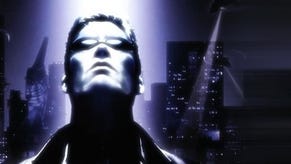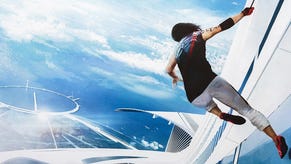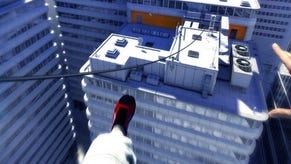Mirror's Edge
Doing a runner.
Mirror's Edge isn't your typical videogame dystopia, and that's exactly the point. There's no rust, no rubble, and no legions of storm troopers running through shattered streets. Instead there's gleaming cleanliness, a spotless high-rise environment of shining steel and glass without a leaf out of place. This is an altogether different vision of hell - a sanitised and well-kept prison where the population have traded their personal freedom for crime-free streets, limitless supplies of sexy gymwear and a shoot-to-kill anti-littering policy. It's a world, you suspect, where somebody has made the trains run on time: a dystopia, then, but a subtle, believable one. That sly kind of thinking is the first sign that Mirror's Edge might be something special.
The second sign is the visuals - and that's in terms of design, not just fidelity and polygon stats. This is a case of form following function, a look dictated by the blank canvas of the city, and the Runner's Vision which allows Faith, the fleet-footed courier protagonist, to instinctively know which environmental objects she can use as she heads from A to B. Rather than highlighting useful bits of scenery in a shimmering videogame glow, the game paints them a primary colour. The results are striking and distinctive, and the few existing Mirror's Edge screenshots are already unmistakable. It's a rare style, and one that would look good running on any system, no matter the hardware power.
And the third, and most important, sign is focus. This is a game about movement, and it elevates the simple act of getting around to a position of prime importance. That's a potential risk, particularly as Mirror's Edge is emphatically first-person, which, when combined with platforming has historically been about as much fun as being backed over by a combine harvester. But there's something about this one that inspires confidence. The developers talk a good game, certainly, but don't they always? Instead, hope lies in the clarity of the design, in the sure-footed poise displayed in the environments and style. Mirror's Edge may finally be the game to break the curse of wonky jumping and floaty combat that ultimately sunk previous first-person action games like Breakdown. It's certainly got ideas as to how it plans on doing it.

For starters, developer DICE has taken pains to put the person into first-person. Look down and you'll see a torso and legs beneath you; jump, and your feet kick out in front, allowing you to guide your descent; run, and you'll find you have to build up speed realistically, each foot that hits the ground providing not just a reassuring animation, but an actual physical sense of movement and connection to the environment. Other games have tried this, and Dark Messiah of Might & Magic got closest, but there were still times your body was clearly just another bit of scenery. For Mirror's Edge to pull it off, the effect has to be near-perfect.
Then there's the control system, which is showing a lot of promise. It's heavily streamlined, but not, thankfully, pared down to the autopilot standards of Assassin's Creed. Given the game's focus on vertical environments, Mirror's Edge's two main buttons are L1 and L2 on the Sixaxis, which are used as 'up' and 'down' (how well this will map to the 360's bumper remains to be seen). Both work contextually: pressing up allows you jump over low railings, or grab ledges and pull yourself onto them; down sends you into a slide if running, or lets you roll under barriers. The system's apparent simplicity hints at a game that wants you to master it quickly and then begin experimenting. You can cludge your way through these levels stupidly, bouncing off air vents and smacking into walls, but you're not getting the most out of the game until you can fling impromptu combos together with abandon, thinking on your feet, and moving through the landscape like a sweatpanted torpedo.
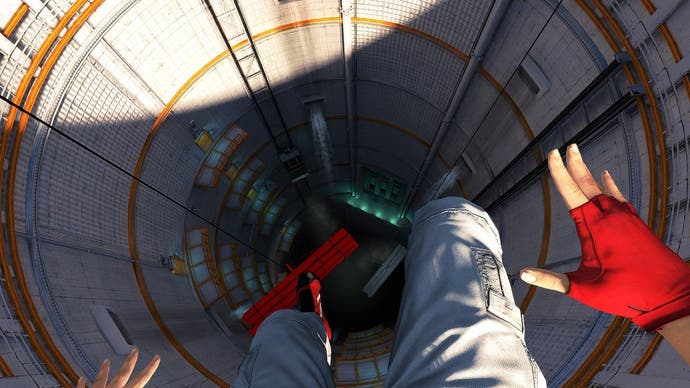
This all sounds fabulous, but there's a problem: if only EA would actually let us have a go at the game ourselves. A recent press event initially suggested that we might finally get to put our feet in Faith's bright red trainers, but our hopes were shattered and it turned out to be another opportunity to watch a developer perform a walkthrough. Chin up, though: at least they showed us some new stuff along the way.
Things kicked off with a leisurely play through the original trailer level - presumably to convince the many doubters present that this is in fact real in-game footage. The blue sky and white buildings are already classics, but the slower pace of the demonstration allowed us to more fully appreciate the way the Runner's Vision washes a layer of pure primary-colour information over the sheer HD city. There's no need for any disruptive third-person camera lunges to mark out your target, a distant door, when the game can make it shine out of the surrounding landscape simply by painting it bright red instead.


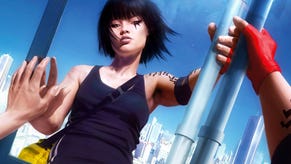
.jpg?width=291&height=164&fit=crop&quality=80&format=jpg&auto=webp)
